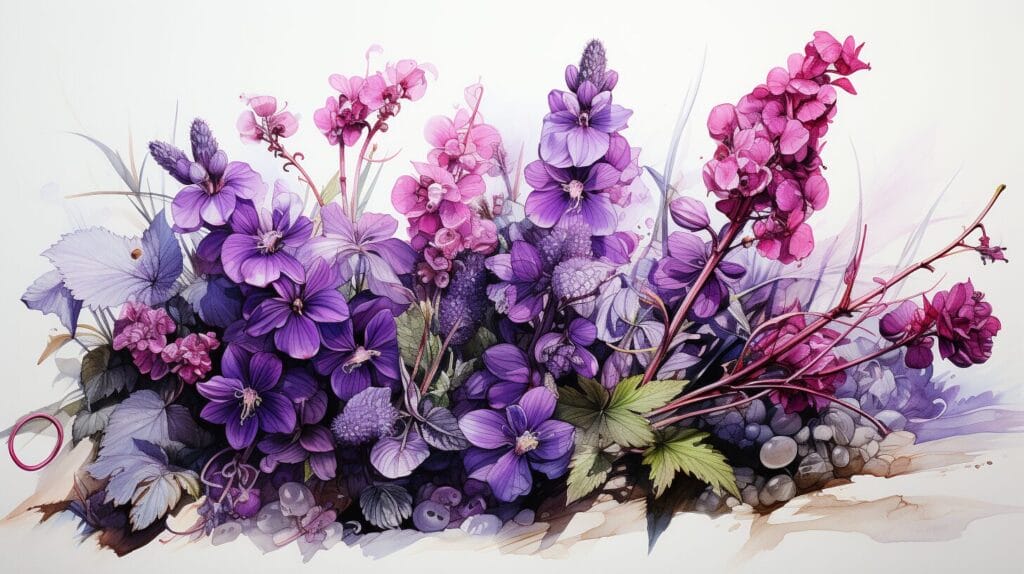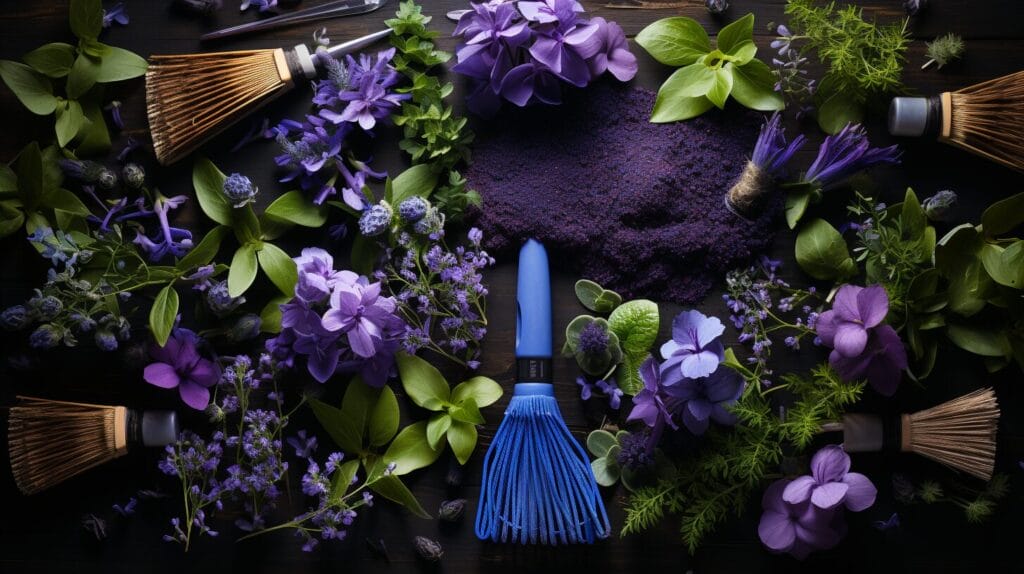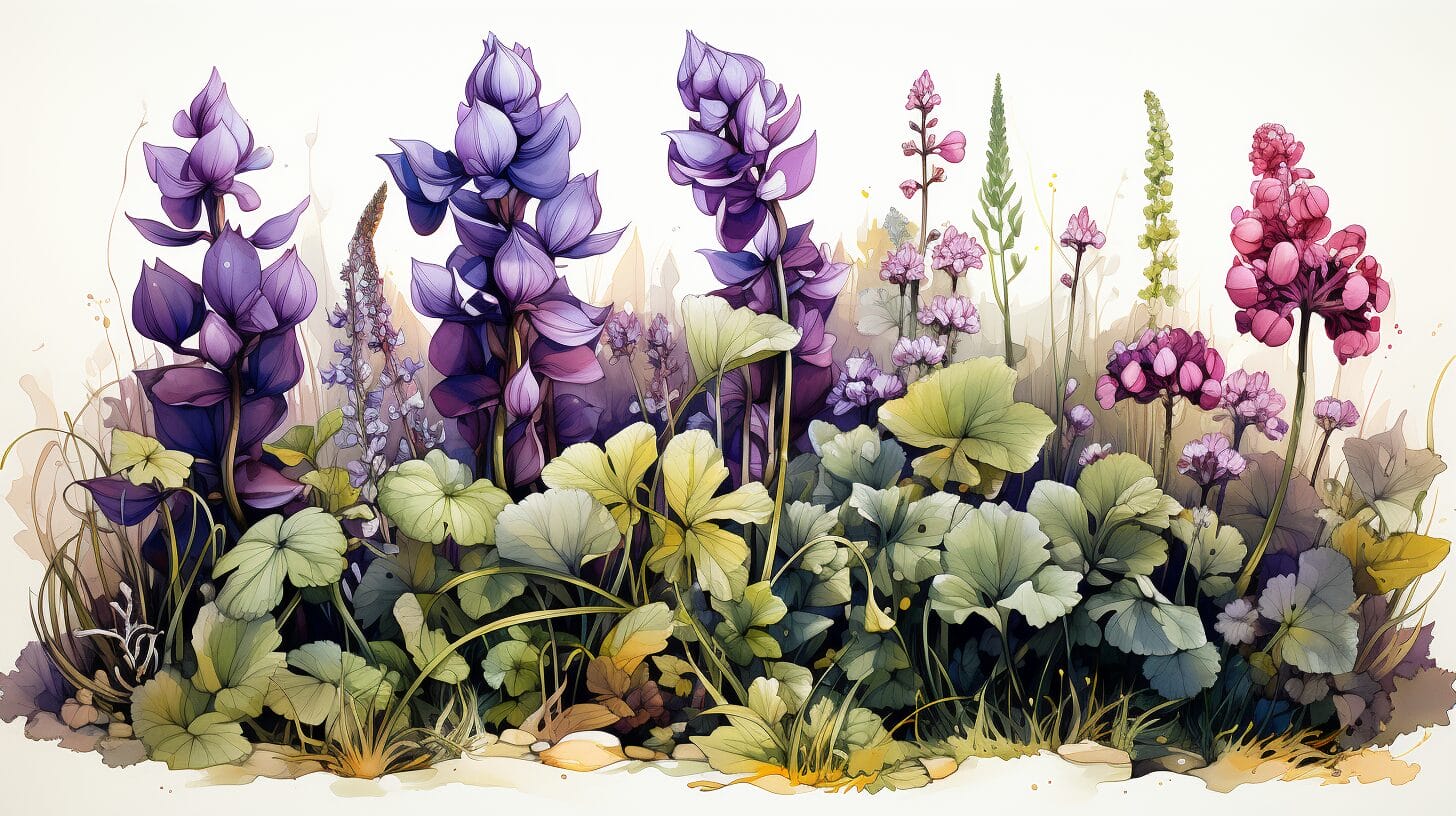As we meticulously maintain our lawn and garden this spring season, we may notice the enchanting purple flowers that routinely bloom. Although their beauty is undeniable, these charming flowers might indicate an unseen conflict occurring below the ground, seeing as the soil perceives them as weeds.
We’re here to tackle this colorful conundrum head-on, sharing professional insights on identifying and managing common, yet often unwelcome, lawn residents like weeds such as purple deadnettle and henbit.
From the creeping charlie to the wild violet, we guide you through distinguishing these species and understanding their impact on your garden ecosystem.
Our comprehensive approach not only highlights identification but also prepares you for the next steps in maintaining the delicate balance of your lawn.
Key Takeaways
- Henbit, wild violet, creeping Charlie, and purple deadnettle are common lawn weeds with purple flowers.
- Understanding the life cycles and behaviors of these weeds is important for effective control.
- Proactive measures such as regular mowing, proper irrigation, and aeration can help prevent the growth of many weeds, including those with purple flowers.
- To manage purple flower weeds, options include regular mowing, using selective herbicides, removing weeds by hand, and applying post-emergent herbicides. Remember, many purple flowers look stunning but are often considered a weed.
Identifying Common Lawn Weeds with Purple Flowers

Identifying common lawn weeds with purple flowers, such as Henbit, Wild violet, and Creeping Charlie, is crucial for maintaining a healthy and attractive lawn.
Henbit:
- Pink/purple flowers sprout in cool, moist areas
- Most visible in early spring
Common Thistle:
- Square stems and rounded, scallop-edged leaves
Wild Violet
- Heart-shaped leaves and delicate purple flowers
- Can quickly take over shaded, fertile soils
Creeping Charlie (Ground Ivy)
- Small purple flowers and scallop-edged leaves
- Forms dense mats that suffocate lawns
- Has a strong root system making it resilient
Understanding these weeds‘ life cycles is key to control. Quickly identifying purple flowering invaders is the first step to reclaiming your lawn
The Science Behind Purple Flowered Weeds: Purple Deadnettle and Common Purple Varieties

Delving into the science behind purple-flowered weeds, we find that species like Purple Deadnettle stand out due to their unique characteristics and lifecycle. These plants play an important role in their ecosystems. Understanding the biology and behavior of these plants helps us manage them effectively.
When looking for weeds with purple flowers, it’s crucial to have a reliable identification guide. Distinguishing features set these plants apart:
- Purple Deadnettle, a weed that can be tricky to get rid of in a lush lawn.Lamium purpureumA common winter weed is the Purple Dead Nettle which is identified by its square stems and purple-tinged leaves, blooming early in the spring.
- Common Purple weeds often share traits such as vibrant purple blooms and a preference for fertile, disturbed soils.
- Creeping thistles and purple loosestrife are invasive and can quickly take over large areas if not controlled.
Early identification and treatment can prevent purple-flowered weeds from becoming unmanageable.
Lawn Care: Proactive Measures to Prevent Common Lawn Weeds

To maintain a lush, weed-free lawn, implement regular mowing, proper irrigation, and aeration practices that support soil health. Consistent mowing helps thwart the growth of common lawn weeds.
Deep, infrequent watering encourages deep root growth, which is essential for a healthy lawn. Overwatering, however, can promote weed growth, so it’s a balance we need to strike.
Aeration is another key proactive measure. Compacted soil can suffocate grass roots and give weeds an advantage. By aerating, we can prevent types of weeds with purple or white flowers from growing as we allow air, water, and nutrients to penetrate the ground, promoting a robust root system for our grass.
With diligent lawn care and regular treatment for common thistle, we can prevent common lawn weeds from taking hold.
Management of Purple Flower Weed: From Ground Ivy to Violet

Once you’ve identified the purple invaders in your lawn, another weed with purple flowers, it’s time to tackle. the management of everything from ground ivy to violets. Effective management involves a combination of cultural practices and, if necessary, the use of herbicides.
Key strategies include:
- Regularly mow your lawn to keep weeds from flowering and seeding.
- Choose a selective herbicide that targets purple weeds and weeds with white flowers, ensuring it’s safe for the grass you want to keep. Many purple weeds have their unique peculiarities which can be used to identify weeds effectively.
- Remove weeds by hand where practical, especially for isolated weed patches or sensitive areas.
For tough weeds like ground ivy, a post-emergent herbicide designed to target broadleaf weeds may be necessary. Read the label and follow instructions closely to eliminate weeds in your grass – such as common thistle, for the best results.
Sustainable Maintenance and Long-term Control of Lawn Weeds

Sustainable maintenance is about establishing an environment where weeds like purple dead nettle struggle to take hold. By monitoring changes in our lawn, we can spot potential problems early and act before they spread.
Integrating weed control into our regular lawn care routine is key for long-term control. Proper mowing, watering, and fertilizing fortify the lawn and make it less inviting for weeds, preventing a situation where we need to get rid of purple-colored weeds like Deadnettle and Henbit.
Deep, strong roots from well-established grass can choke out the root systems of lawn weeds with purple or white flowers, limiting their potential to thrive.
Are Purple Succulent Flowers Considered Lawn Weeds?
Purple succulent flowers may look like weeds to some, but they can add a touch of unique beauty to a lawn. While some may consider them unwanted, others may marvel at their delicate charm. The presence of a purple succulent flower wonder can be a matter of perspective and personal preference.
Conclusion
We’ve explored the world of many purple lawn weeds, uncovering their secrets, how weeds can grow, and strategies for control. Whether it’s Purple Deadnettle or Henbit, we now know what we’re up against.
Let’s keep our lawns lush and healthy by staying vigilant and proactive. The right knowledge and consistent care are our best tools.
Together, we’ll maintain beautiful, weed-free lawns that make our neighbors green with envy. Here’s to our gardening and lawn care success!
Frequently Asked Questions
What is a common Lawn weed Purple Flower that might appear on my lawn?
A common weed with purple flowers that might appear in your lawn or garden is called Purple Dead Nettle. It’s an annual weed and a member of the mint family which characterizes by pretty purple flowers.
How can you distinguish Purple Dead Nettle from other purple weeds in your lawn?
Purple Dead Nettle and Henbit, which is another common weed, along with common thistle belong to the mint family. You can distinguish them by their leaves and flowers. Purple Dead Nettle’s upper leaves are purple, while Henbit’s are green. Their flowers may look similar, but Purple Dead Nettle’s flowers appear all around the stem, while Henbit’s only appear at the top.
What are some common characteristics of Creeping Charlie?
Creeping Charlie, also known as ground ivy, is a fast-spreading weed that can take over your entire lawn or garden. The leaves of this pesky weed are round and emit a minty odor when crushed. It produces pretty purple-blue flowers, which make it attractive but difficult to control, unlike many ordinary purple flowers, many weeds including this one can be an eyesore.
What should I do if I spot a purple weed like Creeping Charlie in my garden?
If you find a type of weed like Creeping Charlie or common thistle in your lawn and garden, the best action is to use a selective broadleaf weed killer. It’s important to treat the garden and lawn area as soon as possible, as this common weed spreads quickly and unlike purple flowers, can take over the garden area.
What type of weed is Creeping Thistle, and how does it appear?
Creeping Thistle is a perennial weed that can be quite invasive. It exhibits purple flower heads that consist of many small flowers. Also, its leaves have a spiny margin adding to its unique appearance. Though the purple flowers are attractive, it’s a weed that can take over your lawn, making it a noxious weed in many areas.






